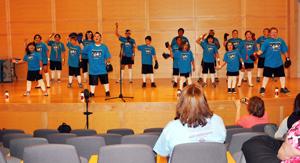For students, Tulalip Tribes' native language a connection to the past
By Gale FiegeThroughout Western Washington, various tribes are working hard to keep the language alive, especially as the elders die, taking with them a firsthand knowledge of Lushootseed.
The women who make up the Tulalip Tribes' Lushootseed Language Department are some of the few who speak it.
Natosha Gobin, 32, has been with the department since she was a Marysville Pilchuck High School student volunteering at the tribes' annual summer language camp. She started her seventh annual language class for families in February; the eight-week class ended on Tuesday.
The women start this final class by practicing in Lushootseed some commands such as "wait," "hurry up," "get ready" and other motherly things they plan to say at home.Below: "From left, Katie Hots, 4; Calista Weiser, 5; KC Hots, 7; Irwin Weiser, 8; Kane Hots, 5; and Aloisius Williams, 2, play Monopoly as Natasha Gobin and her spouse, Thomas Williams, make dinner at their home in Tulalip. Gobin, who teaches Lushootseed language classes, asks her children, KC, Kane, Katie and Aloisius, to count in Lushootseed as they play the game." (Genna Martin/The Herald)














